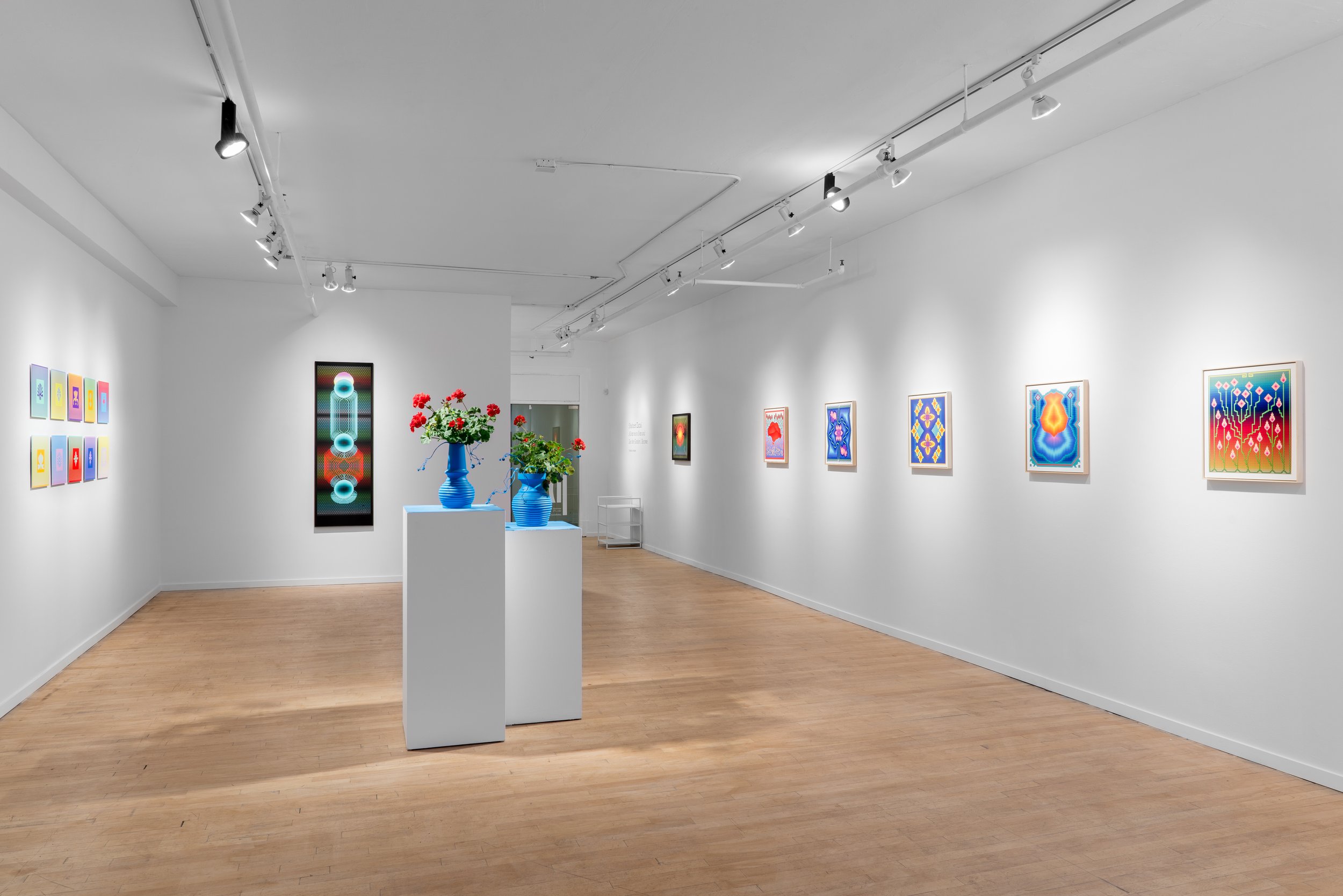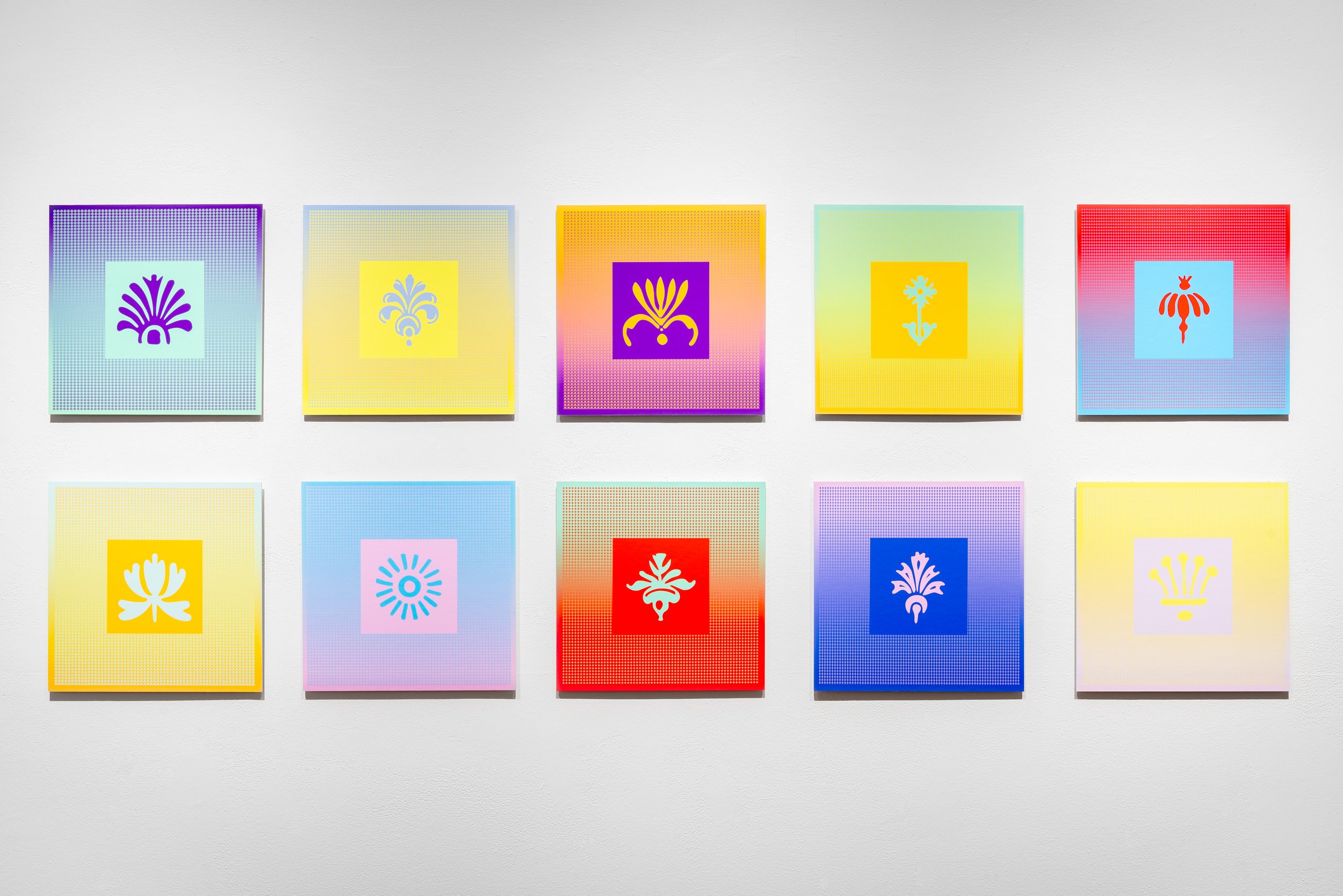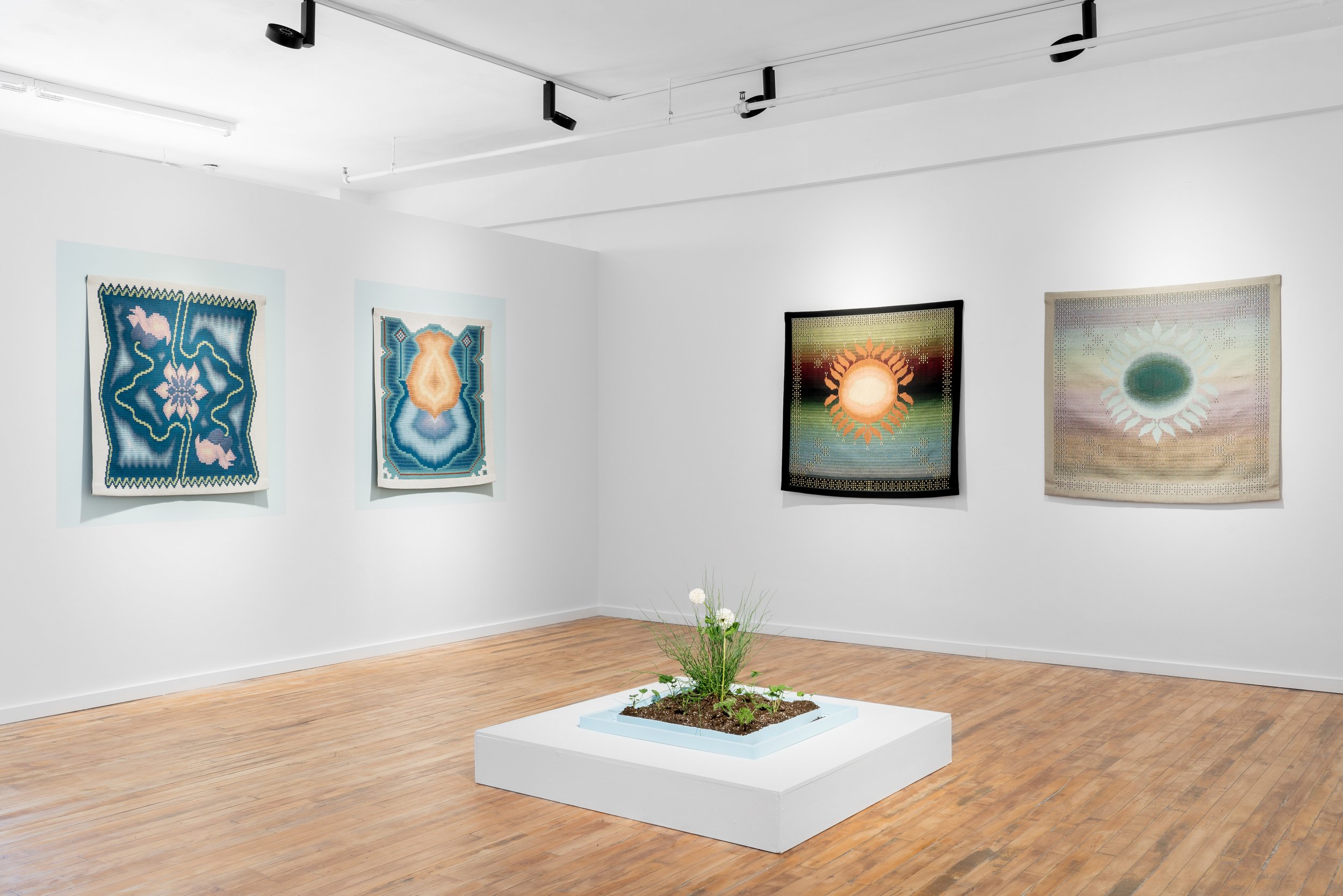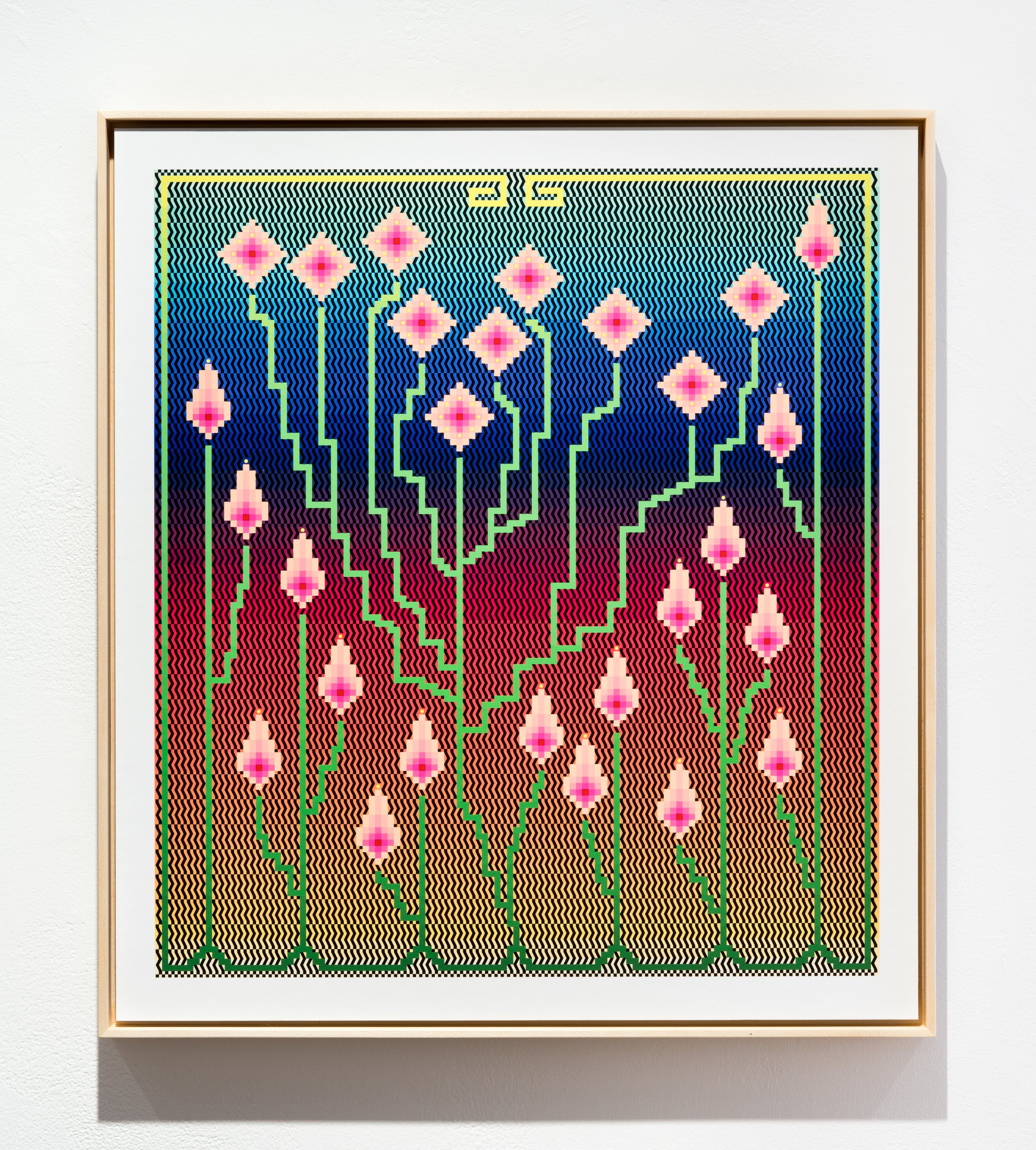Patel brown | The Belgo Building - 372 rue Ste-Catherine O, #412
Shaheer Zazai | Allow me to Sow and See the Garden I Become
…. 31 AUG - 1 OCT, 2023..31 août - 1 oct 2023….
....
Sitting quietly at his computer, Shaheer Zazai types a series of characters in a Word document. Little by little, the page fills and the image of a flower slowly emerges. Each character is important in its own way and is part of a harmonious and complex equation. Each indentation, each punctuation mark is methodically chosen, then highlighted in a carefully selected colour. The image is both controlled and improvised. And although the artist lets his intuition guide him, the flower he is drawing is also calculated to some degree.
As an Afghan-Canadian artist, Shaheer Zazai explores how culture and identity are constructed. In Allow me to Sow and See the Garden I Become, Zazai presents a new body of work in which he continues to reflect on how his country of origin is perceived. Afghanistan has long been associated with ongoing war and conflict, to the exclusion of all other possible facets of its culture. By focusing on the power of flowers and gardens, Zazai tries to activate the hope of transformation while allowing his studio to become a site for meditation and reparation.
Shaheer Zazai’s digital creative process was first inspired by the fabrication of traditional Afghan rugs. His version involves translating hand-knotted threads on a loom into typed characters. The compositions often reflect gardens motifs: a central element, corridors, borders, and ponds reference Afghanistan’s strong gardening tradition. After discovering the book War Gardens, in which reporter Lalage Snow looks at gardening practices in war-torn areas, Zazai delved further into the therapeutic powers of nature and its ineluctable link to resilience and survival. With his recent body of work, he illustrates a precious moment in the life of a plant: its blooming. By representing one or more flowers in each piece, Shaheer Zazai gradually cultivates his own colourful, living, flowering garden. Using the diagrams he draws in his Word document, textile works are then produced on a Jacquard loom, marking the long-standing relationship between computer language and the binary codes behind all weaving patterns.
Zazai’s language also includes an elegant font called “Bodoni Ornaments.” Featured in this exhibition is a series of small-format works presented in a grid, in which each element foregrounds an ornamental character that resembles a stylized flower. As metaphors for actual seeds, these remind us of the germination process that leads to the flowering stage. Zazai thus gives the typographic sign a central space in his work, and as his creative medium it forms the seed of his digital language.
Allow me to Sow and See the Garden I Become is a call for hope, the hope to give cultural identity the chance to show another side of itself. Planting a seed and providing the right conditions for its growth definitively grounds this gesture in the present and is an investment in the future. Shaheer Zazai’s garden offers a pause. It’s a space of transformation and becoming.
Manel Benchabane (translated by Jo-Anne Balcaen)
The floral arrangements presented as part of the exhibition were created by Atelier Bochatay in response to the artist’s work.
..
Assis calmement devant son ordinateur, Shaheer Zazai tape une série de caractères dans un document Word. Petit à petit, la page se remplit, et l’image d’une fleur fait tranquillement surface. Chacun des caractères a son importance et fait partie d’une équation harmonieuse et complexe. Chaque indentation, chaque signe de ponctuation est choisi méthodiquement, puis surligné avec une couleur soigneusement sélectionnée. L’image est à la fois contrôlée et improvisée. Shaheer Zazai se laisse guider par son intuition, bien que la fleur qu’il dessine soit aussi la somme d’un certain nombre de calculs.
Artiste afghano-canadien, Shaheer Zazai se questionne sur les notions d’identité culturelle et de construction identitaire. Avec Allow me to Sow and See the Garden I Become, Zazai présente un nouveau corpus d’œuvres par lequel il poursuit une réflexion sur la perception de son pays d’origine. On associe depuis longtemps l’Afghanistan à un vocabulaire lié à la guerre et au conflit, faisant abstraction de tous les autres aspects possibles de la culture. En se penchant sur le pouvoir des fleurs et du jardin, il tente d’activer l’espoir d’une transformation, permettant par le fait même à son espace de création de devenir un lieu de méditation et de réparation.
Le procédé de création numérique de Shaheer Zazai est d’abord inspiré par les méthodes de confection de tapis traditionnels afghans. Les nœuds faits à la main sur un métier à tisser sont ainsi traduits par des caractères dactylographiés. Les compositions de ces tapis rappellent souvent celles des jardins, avec un élément central, des allées, des bordures et des bassins, faisant écho à l’importante tradition de jardinage en Afghanistan. Après avoir découvert l’ouvrage War Gardens, dans lequel la journaliste Lalage Snow examine les pratiques de jardinage dans les zones de guerre, Zazai décide d’approfondir sa recherche sur la nature et son pouvoir thérapeutique, sur son lien inéluctable avec la résilience et la survivance. Avec ce récent corpus, il illustre un moment précieux dans la vie d’une plante : sa floraison. En représentant une ou plusieurs fleurs sur chacune des œuvres, Shaheer Zazai cultive, petit à petit, son propre jardin, fleurissant, coloré et vivant. À partir des diagrammes dessinés dans les documents Word, des pièces textiles sont aussi réalisées avec un métier Jacquard, marquant la longue relation entre le langage informatique et celui qui permet de composer les motifs d’un tissage.
Une police de caractère élégante intitulée « Bodoni Ornaments » fait aussi son apparition dans le langage de Zazai. L’artiste intègre dans l’exposition une série d’œuvres de petit format présentée sous forme de grille, dans laquelle chacune des entités met au premier plan l’un des caractères incarnant une fleur stylisée. Ces derniers sont une métaphore des semences elles-mêmes, rappelant le processus de germination qui précède l’étape de la floraison. Il accorde ainsi au signe typographique un espace central, celui-ci étant son médium de création, comme la semence de son langage numérique.
Allow me to Sow and See the Garden I Become est un appel à l’espoir, l’espoir de donner la chance à une identité culturelle d’afficher un autre visage. Planter une semence et lui offrir les conditions nécessaires pour grandir est un geste définitivement ancré dans le présent et un investissement vers le futur. Le jardin que fait pousser Shaheer Zazai est une pause. Il est un lieu de transformation, de devenir.
Manel Benchabane
Les arrangements floraux présentés dans l’exposition ont été réalisés par l’Atelier Bochatay en réponse aux œuvres de l’artiste.
....
....
Shaheer Zazai is an Afghan-Canadian artist with a current studio practice both in painting and digital media. Zazai received a BFA from OCAD University in 2011 and was artist in residence at OCAD University as part of the Digital Painting Atelier in 2015. Over the years Zazai’s material vocabulary has expanded into textile work, site-specific public art installations and video works with his lens becoming self-reflective. Zazai is a recipient of Ontario Arts Council grants and he was a finalist for EQ Bank’s Emerging Digital Artist Award in 2018. Since graduating, Zazai has had several solo and group exhibitions such as those at the Capacity 3 Gallery, CAFKA Biennial 2019, Art Gallery of Mississauga, Glenhyrst Art Gallery of Brant., Double Happiness Projects and Patel Brown. His digital works have been covered by CBC Arts in 2018, Ajam Media Collective in 2019 and Globe and Mail in 2020. Some of his recent notable exhibitions include a solo at the Agha Khan Museum in Toronto, participation at a group exhibition at Doris McCarthy Gallery, a solo exhibition at Owens Art Gallery as part of visiting artist program at Mount Allison University in New Brunswick and, a group summer exhibition at The Power Plant Contemporary.
Lydie Bochatay is a florist who lives and works in Upton, Montérégie (Québec). After more than ten years working and taking part in large-scale projects in the visual arts and design milieu, she returned to an artistic practice in 2022 with the founding of Atelier Bochatay. This floristry project, which she annexes to her own garden, is a studio in constant transformation, playing with the boundary between art and floristry and evolving from one proposal to the next.
Manel Benchabane is a curator of contemporary art, a writer, and the manager of exhibitions and public programs at the Stewart Hall Art Gallery. Her curated projects include Entre les lignes—Writing Mountains (2023), Petites baleines à dents— Cynthia Girard-Renard (2022), and La mouvance des sons (2021). She is interested in issues that concern nature and the environment, diversity and cultural issues, heritage, and feminism. She regularly contributes to different contemporary art publications and has served on many committees and juries. ..
Shaheer Zazai est un artiste afghano-canadien dont la pratique en studio combine la peinture et les médias numériques. Il a obtenu un baccalauréat en beaux-arts de l’Université OCAD en 2011 et a été artiste en résidence dans cette même institution dans le cadre de l’Atelier de peinture numérique, en 2015. Au fil des ans, le vocabulaire matériel de Zazai s’est développé en travail textile, en installations d’art public in situ et en œuvres vidéo, sa démarche devenant autoré- flexive. Il est lauréat de subventions du Conseil des arts de l’Ontario et a été finaliste au Emerging Digital Artist Award d’EQ Bank en 2018. Depuis qu’il a obtenu son diplôme, il a présenté plusieurs expositions individuelles et collectives, notamment à la Capacity 3 Gallery, à la CAFKA Biennial 2019, à l’Art Gallery de Mississauga, à la Glenhyrst Art Gallery of Brant, à la Double Happiness Projects et à la galerie Patel Brown. Parmi ses récentes expositions notables, citons un solo au musée Agha Khan de Toronto, une participation à une exposition de groupe à la Doris McCarthy Gallery, une exposition individuelle à la Owens Art Gallery dans le cadre du programme d’artistes invités de l’université Mount Allison au Nouveau-Brunswick, et il fait actuellement partie d’une exposition d’été à la Power Plant Contemporary.
Lydie Bochatay est une fleuriste qui réside et tient un atelier à Upton, en Montérégie (Québec). Après plus de dix ans passés à travailler et à prendre part à des projets de grande envergure dans le milieu des arts visuels et du design, elle renoue avec une pratique artistique en 2022 à travers la fondation d’Atelier Bochatay. Ce projet de fleuristerie qu’elle annexe à son propre jardin est un atelier en constante transformation, se jouant de la frontière entre art et fleuristerie et évoluant d’une proposition à l’autre.
Manel Benchabane est commissaire en art contemporain, autrice et responsable des expositions à la Galerie d’art Stewart Hall. Elle a notamment réalisé les expositions Entre les lignes - Writing Mountains (2023), Petites baleines à dents - Cynthia Girard-Renard (2022) et La mouvance des sons (2021). Elle s’intéresse aux questions de nature et d’environnement, de diversité et d’enjeux culturels, d’héritage et de féminisme. Elle collabore régulièrement à différentes publications traitant d’art contemporain et a siégé sur différents comités et jurys.
....










